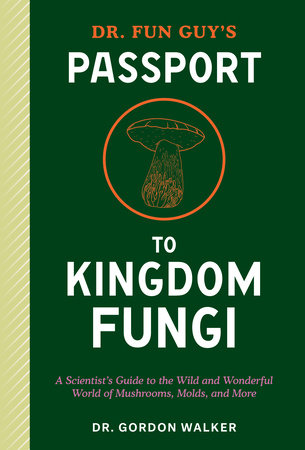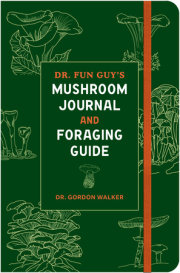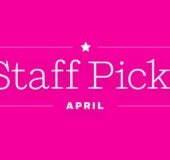IntroductionMy fascination with fungi has deep roots in my childhood. In the summers, my family would make the drive from Boston up to Lake Tremblant, a couple hours outside of Montreal, to spend time at my grandparents’ cabin; surrounded by a richly diverse forest, populated with paper birch and pine trees along with numerous animal denizens. While walking through the woods, I would see mushrooms popping up through the deep lush layers of fallen leaves and pine needles on the forest floor. One day, a particularly slimy green mushroom caught my attention. This was the aptly named parrot mushroom (
Gliophorus psittacinus), known for its slippery green cap and brilliant yellow stem. As an enthusiastic child, I was convinced that this strangelooking organism must be an alien life form from another planet. How else could something so otherworldly come to be here unless it was extraterrestrial? My grandfather patiently explained to me that it was, in fact, a mushroom and that it belonged to a group of other brightly colored types known as waxcaps (see page 237). At the time, I was skeptical, but that little alien-looking mushroom helped seed a lifelong obsession.
A passion for mushrooms and a love of nature run in my blood. I did not know it when I was getting started, but my great-grandmother was an avid mushroom hunter. My parents have also played an important role in shaping and guiding my fascinations. My father is a biology professor who instilled within me the central dogma of biology at a young age, along with a love for gardening and cooking. My mother is a computer programmer turned artist, who taught me to appreciate both technical details and the intricate nuances of natural textures. It was through the lens of my family’s enthusiasm for knowledge and nature that I learned to see the world.
When I was around 5, my mother and I came across a sizeable puffball (see page 182) while out on a walk in Massachusetts. She recognized it as an edible mushroom, so we carefully plucked it from the grassy field and brought it home. Sweet nutty aromas filled the air as we fried it in butter. I got my first taste of the pillowy soft puffball and was immediately hooked on mushroom foraging, drawn in by the allure of finding delicious food out in the woods. We never found another puffball in the same spot, but there were plenty of mushrooms closer to home. When we cut down an old tree in the yard, my father decided to inoculate the stump with chicken of the woods (see page 167) plug spawn. A year later, when I had completely forgotten my initial excitement, brilliant orange and yellow growths spewed forth from the decaying stump. We carefully harvested the soft, supple shelves and brought them inside to pan-fry in butter. My mind was blown when I tried a piece and found it had a virtually identical texture and flavor to chicken. As a budding chef, I was immediately enthralled by the endless delicious culinary possibilities of this meaty mushroom.
During a particularly wet fall, large clusters of mushrooms began appearing around the base of our decrepit apple tree. I was chomping at the bit to eat this fantastic flush of fruiting bodies. We referenced our books and guessed that they were honey mushrooms (see page 186). My ever cautious parents decided we should seek the advice of a mycologist. We harvested one of the clusters and brought it into the Boston Mycological Club to have our suspicions confirmed. They confirmed that these were honey mushrooms but advised consuming with caution, as they can cause gastrointestinal upset. Undeterred by this warning, I set about cooking up the caps, finding the texture slimy but the flavor scrumptious (fortunately I experienced no discomfort). We made plans to go on a foray in the fall, but then disaster struck. I became an anxious, pimply preteen, and everything associated with my parents that I once thought was cool suddenly became profoundly uncool, including mushrooms.
My fascination with fungi faded into the background as I spent much of my high school and college years preoccupied with the ocean, focused on sailing and scuba diving. However, my interest in fungi was reignited by the delightfully bubbly beverage known as beer. The captain of our sailing team at UC Santa Cruz was an avid homebrewer who kept several tasty concoctions on tap at all times. In the process of learning about the technical aspects of beer making, I came face to (metaphorical) face with fungi again, this time in the form of yeasts (see Food-Associated Yeasts, page 243). I found myself particularly intrigued by how different strains could dictate the style of beer and how by manipulating fermentation conditions, you could influence the aroma produced by the yeasts. The desire to dive deeper into the biochemistry of yeast drove me to apply to UC Davis for graduate school and join the lab of Dr. Linda Bisson. For my graduate research, I studied how nutrition and microbial communities impact the performance of yeasts during the fermentation of wine. This experience primed me to embrace self-directed learning, critical thinking, and taught me how to communicate complex scientific concepts to diverse audiences. Most importantly, it forced me to empathize with fungi to better understand life from the perspective of my yeasty test subjects.
After completing my PhD, I spent time traveling and ended up living in New Zealand for several months. I was working on writing up my research from grad school for publication, but I found the allure of nature a necessary distraction for my mental health. Thanks to multiple typhoons that washed over the island that year, I was able to find a variety of mushrooms that rekindled my childhood fascination.
My gateway finds were the delightfully fuzzy light brown mushrooms known in Māori as tawaka (
Cyclocybe parasitica) and the diminutive but brilliant orange pore conch (
Favolaschia calocera). After first finding tawaka on a hike, I dove deep into online resources, but without the knowledge or language to describe it, I found identification difficult. Thankfully, a friend on Instagram was able to tip me off to its identity, setting the stage for me to use social media as a mechanism for learning about and sharing my mushroom finds. I started posting pictures and descriptions of mushrooms on Instagram in 2017, never expecting that it would fundamentally alter the course of my life.
My symbiotic relationship with social media has nourished my fascination with fungi, providing an outlet for my creative expression and a virtual community where I have been able to build friendships and learn from experts. Through my atFascinatedByFungi accounts I have been able to reach and teach millions of people about the amazing diversity of fungi by presenting visually stunning, emotionally engaging, and entertaining educational content. My hope is that exposing people to mushrooms and other fungi will inspire them to learn more on their own and take an active role in advocating for and helping to conserve threatened habitats. Writing this book is the culmination of all of the educational outreach I have done through social media. This project has served as a way for me to solidify my own knowledge, while also sharing with others what I wish I had known when I first started foraging.
This book is intended as an in-depth introduction to the fungal kingdom—exploring not only macrofungi like mushrooms and lichens, but also the wild world of microfungi, including yeasts, molds, and aquatic fungi through both broad overviews and specific examples. You can read it all the way through or bounce around at will (as I often do when I am excited about a topic). The chapters are organized in a question-and-answer format, so you can jump to the parts you’re most curious about. The mushroom morphology section is meant to act as a companion to other field guides, helping you to translate what you see into language you can use to research and identify fungi. The fungal profiles are not intended as a strict identification guide, but rather as an introduction to the edible, toxic, functional, and otherwise common mushrooms you might encounter. There are QR codes throughout that link to iNaturalist.org and other specific resources that help provide more educational context and additional examples of the fungi mentioned. The full end notes and cited references are also available via QR code (see References, page 299). The first mention of glossary terms in the book are denoted in
bold, (see Glossary Terms, page 291).
The ways we study fungi are shifting quickly, and what we know is constantly evolving. While I can’t cover all the details and nuances of fungi in this book, I do my best to present the most up-to-date and accurate information. However, chances are that new understandings will have emerged by the time this book is published. Scientific names and classifications are especially prone to change. Always keep an open mind to new possibilities and be ready to adapt your perceptions based on novel data. Despite a history of fear and misinformation surrounding mushrooms, society is finally coming around to perceiving fungi as friends. We are witnessing the dawning of a new era of fungal appreciation. Now is the time to give fungi our full attention and understanding, recognizing their interconnected nature and the essential roles they play worldwide. My hope is that this book will fuel your personal curiosity and inspire you to follow your own fascination with fungi.
Copyright © 2025 by Dr. Gordon Walker. All rights reserved. No part of this excerpt may be reproduced or reprinted without permission in writing from the publisher.
















